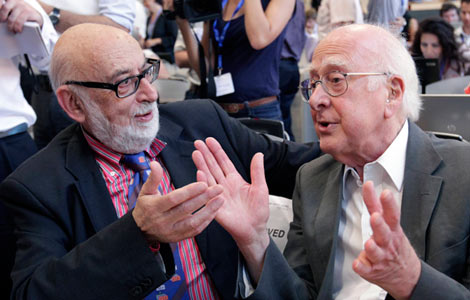Higgs and Englert win physics Nobel prize
Updated: 2013-10-09 03:15
(Agencies)
|
||||||||
STOCKHOLM - Britain's Peter Higgs and Francois Englert of Belgium won the Nobel Prize for physics on Tuesday for predicting the existence of the Higgs boson particle that explains how elementary matter attained the mass to form stars and planets.
The insight has been hailed as one of the most important in the understanding of the cosmos. Without the Higgs mechanism all particles would travel at the speed of light and atoms would not exist.
Half a century after the scientists' original prediction, the new building block of nature was finally detected in 2012 at the European Organization for Nuclear Research (CERN) centre's giant, underground particle-smasher near Geneva.
"I am overwhelmed to receive this award," said Higgs, who is known to shun the limelight and did not appear in public on Tuesday despite winning the world's top science prize.
"I hope this recognition of fundamental science will help raise awareness of the value of blue-sky research," he said in a statement via the University of Edinburgh where he works.
The two scientists had been favourites to share the 8 million Swedish crown ($1.25 million) prize after their theoretical work was vindicated by the CERN experiments.
To find the elusive particle, scientists at the Large Hadron Collider (LHC) had to pore over data from the wreckage of trillions of sub-atomic proton collisions.
The Higgs boson is the last piece of the Standard Model of physics that describes the fundamental make-up of the universe. Some commentators - though not scientists - have called it the "God particle", for its role in turning the Big Bang into an ordered cosmos.
Higgs' and Englert's work shows how elementary particles inside atoms gain mass by interacting with an invisible field pervading all of space - and the more they interact, the heavier they become. The particle associated with the field is the Higgs boson.
The Royal Swedish Academy of Sciences said the prize went to Higgs and Englert for work fundamental to describing how the universe is constructed.
"According to the Standard Model, everything, from flowers and people to stars and planets, consists of just a few building blocks: matter particles."

 Last photos of Hungarian wingsuit diver
Last photos of Hungarian wingsuit diver
 In photos: Typhoon Fitow aftermath
In photos: Typhoon Fitow aftermath
 Japan-US military drill raises tension
Japan-US military drill raises tension
 Higgs and Englert win physics Nobel prize
Higgs and Englert win physics Nobel prize In Bali, they relax in local fashions
In Bali, they relax in local fashions
 Post office for Liaoning carrier opens
Post office for Liaoning carrier opens
 A smog-filled Beijing targets polluting cars
A smog-filled Beijing targets polluting cars
 Animal welfare to be added in training
Animal welfare to be added in training
Most Viewed
Editor's Picks

|

|

|

|

|

|
Today's Top News
Trending News across China on Oct 9
Xiaomi's Barra ready to take on Beijing
A day of cultural exchange at Pace University
ZTE, Houston Rockets shooting for global markets
Global firms facing HR challenges in Asia
Back to 1942, entered for the 86th Oscars
Obama says he'll negotiate once 'threats' end
Unprotected sex brings sharp rise in HIV/AIDS
US Weekly

|

|







